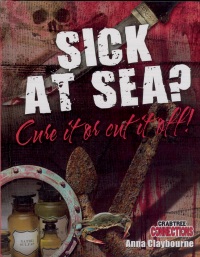| ________________
CM . . . . Volume XVII Number 33 . . . . April 29, 2011
excerpt:
Perhaps those living in the 24th century will look back at how medicine was practiced in the 20th century and think that our "modern" doctors/surgeons were just a bunch of ignorant quacks. Claybourne invites her readers to return to the 17th century where they can become a ship's doctor or surgeon during that period. Each pair of facing pages constitutes a "chapter" with the opening one listing the contents of the ship's surgeon's medicine chest and his tools and supplies. The former included such "medical supplies" as rhubarb, cinnamon, honey, turpentine and vinegar. The remaining dozen chapters each deal with a medical condition that might confront the ship's surgeon. These include fevers, toothaches, fractures, vomiting and diarrhea, coughs, colds and headaches, battle wounds, infected and gangrenous wounds, amputations, sunstroke and frostbite, scurvy and hallucinations. For each of the medical conditions, Claybourne provides a list of what the ship's surgeon would need and the steps required in the treatment process. For example, Taking a tooth out Readers will have undoubtedly noticed that there is no mention of "freezing" the area around the tooth that is to be extracted. Rum or opium were the period's principal painkillers, and it appears that the pain from a tooth extraction was considered insufficient to merit the employ of either. As one has come to expect of Crabtree publications, Sick at Sea? is generously illustrated with numerous colour photographs, and "fact boxes" supplement the main text by providing additional information. For instance, on the pages dealing with "Stomach Bugs," a fact box labeled Seasick admiral informs readers that "English admiral Lord Horatio Nelson spent his life at sea. Although he loved ships, he suffered from terrible seasickness. He often had to stay in his bed for days on end." Those familiar with Crabtree books will know that the book concludes with a glossary of words that had been bolded in the text, a brief webography/bibliography and an index. Given the brevity of the book, perhaps two of the three pages given over to these supplementary features could have been better used for more content. The one slightly off-putting aspect of Sick at Sea? is the font that is used to introduce each chapter. Meant to resemble hand printing, it is, at times, somewhat difficult to read. Though Sick at Sea? is not an essential purchase for school or public libraries, its delightfully "gross" contents could be found especially appealing by reluctant readers. Recommended. Dave Jenkinson, CM's editor, lives in Winnipeg, MB.
To comment
on this title or this review, send mail to cm@umanitoba.ca.
Copyright © the Manitoba Library Association. Reproduction for personal
use is permitted only if this copyright notice is maintained. Any
other reproduction is prohibited without permission.
NEXT REVIEW |
TABLE OF CONTENTS FOR THIS ISSUE
- April 29, 2011.
AUTHORS |
TITLES |
MEDIA REVIEWS |
PROFILES |
BACK ISSUES |
SEARCH |
CMARCHIVE |
HOME |
